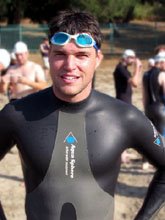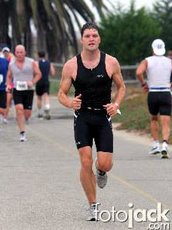A few weeks ago I mentioned an old buddy and lifting partner of mine in this blog. As Internet karma would have it, he wrote me shortly after that and we started up some online fitness gabbing. Now Deano's no fitness aficionado like me, just a lowly, barely-literate Ph.D in biology, so, predictably, he had a few questions for me. I thought I'd post a piece of our back-and-forth here.
A track-and-fielder in school, Deano's currently trying to break the 5-minute mile barrier, his own personal Everest. (In a previous email to Deano I mentioned Chad Waterbury, the iconoclastic strength coach I mention here, and that's the "Chad" he's referring to):
It seems like Chad favors exercises that use multiple muscle groups simultaneously to build strength and mass in any given group. You and I used to talk about isolating muscle groups to really hit them. His approach does make a lot of sense to me when the goal is to perform a task efficiently: My training for the mile is largely about learning to run a 5 minute mile pace without putting any needless stress on any one part of the body. But I'm surprised that his approach works better if the goal is to bulk up a particular muscle group. In other words, I'm saying that his philosophy sounds like what I do, not what I thought a weight lifter does.
The idea of isolating a single muscle group -- which is not physiologically possible -- comes from bodybuilding. Most people seeking to add the maximum amount of muscle to their frames perform lots of single-joint exercises like curls, calf raises, leg extensions and the like, in addition to old-school compound moves like squats and presses. Some coaches and online lifting junkies may dispute me on this, but, based on what I know of the training protocols of most serious bodybuilders, and from my own personal experience, performing some single-joint training is crucial if getting maximally buff is your number one training goal.
Much of the thinking about muscle isolation comes out of the Weider school, where every common-sensical lifting axiom has "Weider" stuck in front of it, as in "The Weider 'Gravity Exists' Principle," or "The Weider 'Oceans are Wet' Theory." Weider's books and magazines were certainly my main source of lifting advice back when you and I were pumping iron back in Hanover, so that's why I trained that way: I didn't know any different!
Weider has been taking a lot of heat lately, but lots of guys get effectively huge using those methods (with perhaps some help from a needle or two) and as I said, the majority of people who are big for a living seem to continue to use them. However, Waterbury and many of the other pioneers these days, like Alwyn Cosgrove and Mike Boyle, come at things from a slightly more functional/athletic standpoint (though Boyle's blood might boil if he read 'functional' next to his name!). They are less interested in muscle for muscle's sake than in health, strength, and athletic performance with improved appearance as a desirable side effect.
But there are subtle differences even among the approaches of this new wave as well. Waterbury's background is in weightlifting (more concerned with strength than appearance); Cosgrove is a fat-loss expert (mostly concerned with body composition); and Boyle is an athletic coach (mostly concerned with keeping pro athletes healthy and strong). So all these heavy hitters have their own angle, and none of them are focused as exclusively with turning you into Quadzilla as Weider was -- or as you and I were back in the throes of our 1980's teenage machismo.
Again, the faithful will claim that the system devised by their respective figureheads works best for everything: strength, muscle mass, body composition, power, sports performance, looking good naked. But I don't find that to be true. I've never been as big as I was in college, when I was using a Weider-esque body part split, but I got very lean using Cosgrove's methods and felt quick and athletic on Boyle's programs. I'm only a few weeks into using Waterbury's methods, but I can already feel myself getting stronger on key lifts.
Obviously there's some convergence among all these methods: Boyle's athletes still look great; Waterbury's charges still get lean; Weider devotees still get strong. It's more of a question of emphasis than developing one quality to the exclusion of all others. But if a band of evil robots came to Earth and threatened to devour anyone with over 10% bodyfat, I'd put Cosgrove in charge of the worldwide fat-loss blitz. If the same robots said they had a hankerin' for any puny earthlings who couldn't bench press twice their bodyweight, I'd elect Waterbury to Benching Czar. And if the robots gave us a sporting chance and said they'd let us go if we could best them at a human-on-robot game of flag football, I'd nominate Mike Boyle to head up the strength-and-conditioning department of Earth's Beat The Robots team.
The other guys would be deputies, no question. But even specialists have specialties.
As pretty much every great coach has acknowledged, it's easy to get caught up in the small variations that make up 15% of the experts' programs, such as whether an isolation move or two is worth the time in the gym. Far more productive is to focus on the 85% that they DO agree on and make sure you're getting plenty of that. What this all goes to show is that, unsurprisingly, there is no single best way to train for every individual for every goal. And frankly I like it that way: without a little variation, without even -- dare I say -- a little good-natured frisson among the experts and their acolytes, I'd probably have to pack up my blog and go home.
Wednesday, July 18, 2007
A Ph.D Asks ME a Question
Labels:
alwyn cosgrove,
Chad Waterbury,
evil robots,
Joe Weider,
Mike Boyle
Subscribe to:
Post Comments (Atom)




1 comment:
This is a marvelous explanation of the differences between the weight-lifting camps, sir, and I appreciate you dishing out the knowledge. :-)
Post a Comment